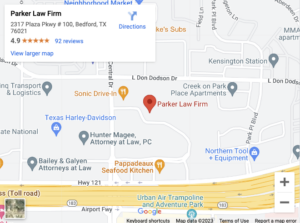
After an accident, one of the biggest determinants of your compensation is liability. You may have heard this term used to describe someone or something that is risky. The legal definition is slightly different.
It is crucial for you and your family to be empowered with information and understand the significance of liability in personal injury cases.
What Is Liability?

Liability refers to legal responsibility or accountability for an event or action that causes harm to someone else. In the realm of personal injury law, liability often pertains to the legal obligation of a party to compensate another. This is typically compensation for injuries caused by the at-fault party’s actions or negligence.
Personal injury claims are largely negligence claims, which result when someone does not meet the standard of care expected of them. However, in rare cases, people may also be injured due to intentional actions or under strict liability principles.
Liability for Negligence Torts
Negligence is a common basis for personal injury claims. It involves the failure to exercise reasonable care, resulting in harm to others. To prove negligence, a plaintiff typically needs to establish four elements: duty, breach of duty, causation, and damages.
The duty of care is essential to establishing liability. Parties are more likely to be held liable if they have a special duty of care and fail to meet that standard. For instance, a grocery store owner has a duty to monitor and remove hazards on the premises. If they failed to do this, and a customer slips and falls on a spill, they may be liable even if they did not cause the spill.
Intentional Torts Liability
Intentional torts occur when a person intentionally acts in a way that causes harm to another. This could include assault, battery, defamation, or intentional infliction of emotional distress. Personal injury claims based on intentional torts are rare but not impossible. If an employee assaults a customer while acting as an employee, the employer may be liable for those actions.
Strict Liability Torts
Strict liability applies when a defendant is held responsible for an injury regardless of their intent or level of care. This liability is often applied to dangerous activities like blasting or handling wild animals. Product liability cases also fall under strict liability. In product liability, a manufacturer is liable for injuries caused by a defective product, design, or manufacturing.
Liability for Common Types of Injuries in Personal Injury Cases
Understanding the common types of injuries that can result from an accident can shed light on the extent of damages for which one may be liable. Damages compensate plaintiffs for their injuries. An at-fault party may be liable for any of the following kinds of injuries to the other party.
Physical Injury
Physical injury is the most common type of injury for which one may be liable. These include whiplash, broken bones, soft tissue damage, traumatic brain injury, nerve damage, and paralysis. Because treatment costs are tangible and measurable, physical injuries are compensated by economic damages.
Emotional Injury
After an accident, parties may experience emotional distress from the accident, including anxiety, depression, and post-traumatic stress disorder. They may also experience pain and suffering due to their physical injuries. Plaintiffs may claim certain special types of damages, called non-economic damages. These damages compensate for the loss of enjoyment of their daily activities and the impact on their relationships with loved ones.
Financial Injury
Plaintiffs can claim economic damages relating to property damage from the accident. They can also claim damages for lost wages during the recovery period or a loss of earning capacity due to the injury.
Determining Liability in Texas
Fault laws determine where the injured party starts when filing a claim. In a no-fault state, the injured party must first file a claim with their insurance company, even if the other party is clearly at fault. However, the injured party does not need to prove fault.
Texas is an at-fault state. That means that the injured party can directly sue the party that caused the accident. However, the injured party’s insurance policy must cover the total amount of the claim. In an at-fault state, the injured party must also prove that the other party was at fault.
If multiple parties were responsible, you may recover compensation for your injuries while still being liable for the other party’s injuries. Texas has adopted a modified comparative fault law. This means you can recover compensation if you are not more than 50 percent at fault for the accident. Your total recovery will be reduced by the portion of the accident for which you were at fault.
Contact a Fort Worth Personal Injury Lawyer for Help Proving Liability
If you have been injured in an accident in Fort Worth, TX, you do not have to navigate the legal landscape alone. Contact the law offices of Parker Law Firm Injury Lawyers at (817) 839-3143 to schedule your free consultation today. Our Fort Worth personal injury attorneys will walk through your case’s facts, discuss the parties’ possible liability, and fight for the best outcome for you.


